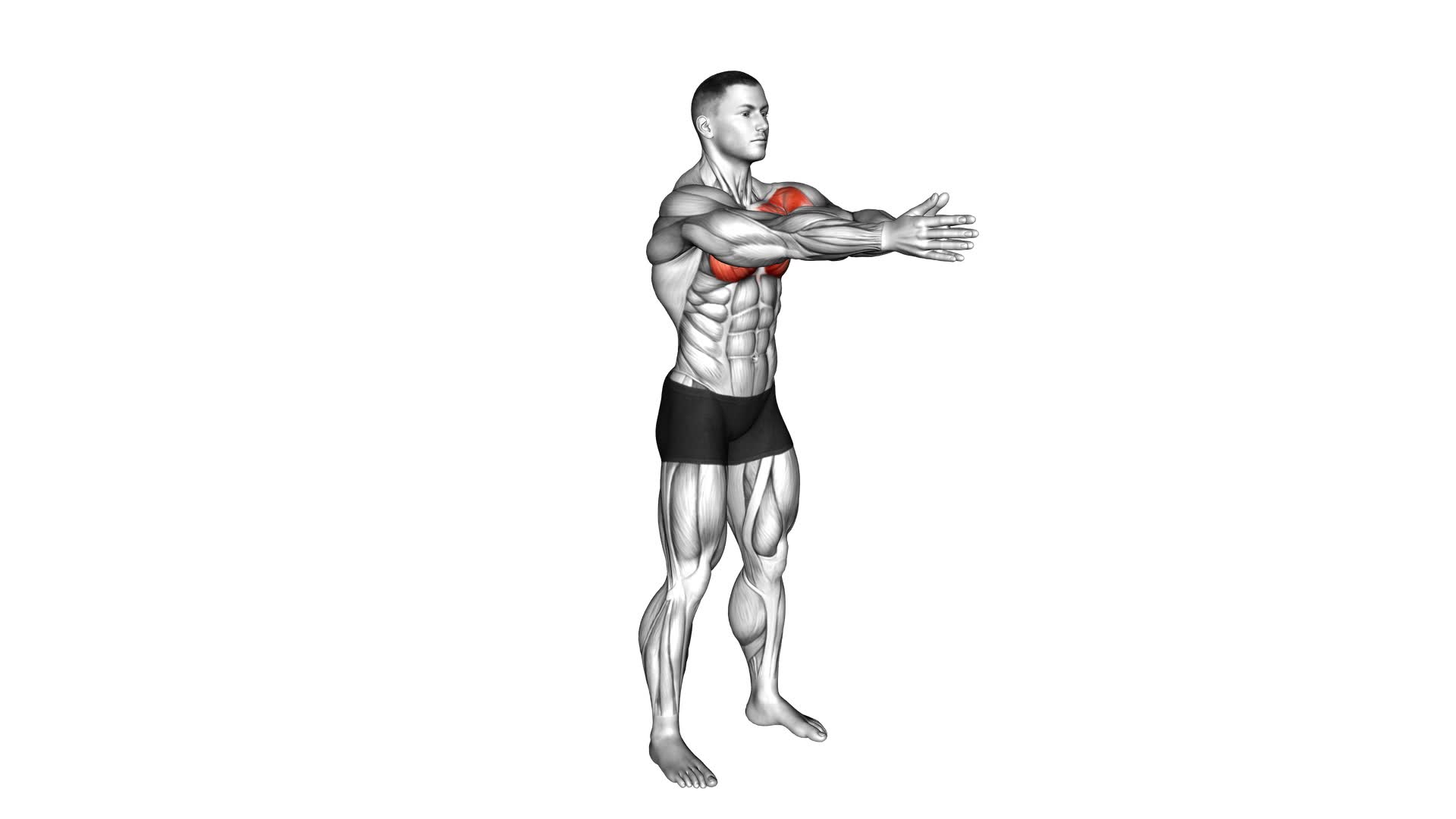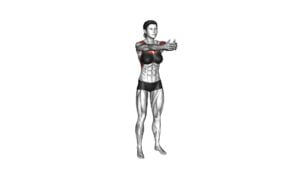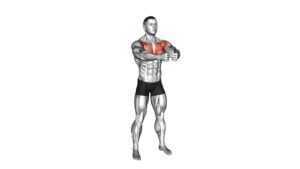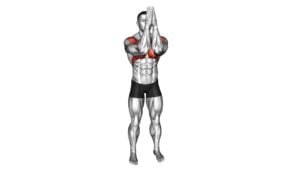Bodyweight Standing Straight Arm Chest Fly (male) – Video Exercise Guide & Tips

Are you looking for an effective chest exercise that you can do anywhere? Look no further than the bodyweight standing straight arm chest fly.
Watch This Exercise Video
This exercise targets your chest muscles and helps improve your upper body strength.
In this video exercise guide, you'll learn the proper form and technique, as well as variations for different fitness levels.
Avoid common mistakes and get the most out of this exercise with our helpful tips.
Let's get started!
Key Takeaways
- Targets chest muscles and improves upper body strength
- Engages core muscles for stability and balance
- Helps improve upper body stability and posture
- Maximizes muscle activation by focusing tension and resistance on chest muscles
Benefits of the Bodyweight Standing Chest Fly
Discover the benefits you can gain from incorporating the bodyweight standing chest fly into your workout routine. The standing chest fly is a highly effective exercise that targets the muscles in your chest, specifically the pectoralis major and minor. By utilizing your own bodyweight as resistance, you can experience several advantages.
Firstly, the bodyweight standing chest fly allows for a greater range of motion compared to traditional weightlifting exercises. This increased range of motion allows you to fully stretch and contract your chest muscles, leading to improved muscle development and overall strength. Additionally, the standing position engages your core muscles, promoting stability and balance throughout the exercise.
Another advantage of the bodyweight standing chest fly is its effectiveness in targeting the chest muscles without placing excessive strain on your joints. This makes it a suitable exercise for individuals with joint issues or those looking to minimize stress on their joints.
Incorporating the bodyweight standing chest fly into your workout routine can provide you with a challenging and efficient way to strengthen and sculpt your chest muscles. Now, let's move on to the next section where we'll discuss the proper form and technique for this exercise.
Proper Form and Technique for the Exercise
To perform the bodyweight standing chest fly with proper form and technique, you need to follow these steps:
- Stand with your feet shoulder-width apart and your arms extended out to the sides, parallel to the floor.
- Engage your core and keep your back straight throughout the exercise.
- Slowly bring your arms forward, crossing them in front of your body, while maintaining a slight bend in your elbows.
- Pause for a moment at the peak of the movement, feeling the stretch in your chest muscles.
- Slowly return your arms back to the starting position, keeping control and tension in your chest muscles.
When performing the bodyweight standing chest fly, it's important to avoid common mistakes such as:
- Using momentum to swing your arms instead of engaging your chest muscles.
- Shrugging your shoulders or arching your back, which can put unnecessary strain on your neck and lower back.
- Holding your breath during the exercise. Instead, remember to inhale as you bring your arms forward and exhale as you return them back to the starting position.
Targeted Muscles and Muscle Activation
Engage your chest muscles and maximize muscle activation with the bodyweight standing straight arm chest fly exercise. This exercise primarily targets the chest muscles, specifically the pectoralis major and pectoralis minor. These muscles play a crucial role in movements involving the arms and shoulders, such as pushing and lifting. By performing the standing straight arm chest fly, you can effectively strengthen and tone your chest muscles.
The exercise effectiveness of the bodyweight standing straight arm chest fly lies in its ability to isolate and target the chest muscles. By keeping your arms straight and slightly bent at the elbows, you're able to focus the tension and resistance directly on the chest muscles, ensuring maximum activation and engagement. This exercise also helps improve upper body stability and posture.
To perform the bodyweight standing straight arm chest fly, begin by standing tall with your feet shoulder-width apart. Extend your arms straight out in front of you, palms facing forward. Slowly bring your arms out to the sides, maintaining a slight bend in the elbows, until you feel a stretch in your chest muscles. Pause for a moment before returning to the starting position. Repeat for the desired number of repetitions.
Incorporating the bodyweight standing straight arm chest fly into your workout routine can help you achieve a stronger, more defined chest.
Variations and Modifications for Different Fitness Levels
Continue targeting and engaging your chest muscles with variations and modifications of the bodyweight standing straight arm chest fly exercise to accommodate different fitness levels. Here are some variations and progressions you can try:
- Increased resistance: If you find the bodyweight standing straight arm chest fly too easy, you can add resistance by using dumbbells or resistance bands. This will challenge your chest muscles even more and help you build strength.
- Single-arm variation: Instead of using both arms simultaneously, try performing the exercise with one arm at a time. This will require more stability and coordination, and will also help you identify any strength imbalances between your left and right sides.
- Incline or decline chest fly: To target different areas of your chest, you can adjust the angle of your body. Performing the exercise on an incline bench will emphasize your upper chest, while a decline bench will target your lower chest.
- Plyometric chest fly: For an advanced variation, you can add an explosive element to the exercise. Start with your arms extended, then quickly bring them together in a clapping motion. This won't only work your chest muscles, but also improve your power and explosiveness.
Remember to choose variations and progressions that are appropriate for your fitness level and always maintain proper form to avoid injury.
Common Mistakes to Avoid
When performing the bodyweight standing straight arm chest fly exercise, it's important to be aware of common mistakes to avoid. By understanding these mistakes, you can ensure that you're getting the most out of your workout and avoiding any potential injuries.
One common mistake is using too much weight or resistance. It's important to start with a lighter weight and gradually increase it as you become more comfortable with the exercise.
Another mistake is using improper form. Make sure to keep your arms straight, your core engaged, and your shoulders down and back throughout the entire movement.
It's also important to avoid swinging your arms or using momentum to complete the exercise. This can take away from the effectiveness of the exercise and put unnecessary strain on your joints.
Lastly, be mindful of your breathing. It's common to hold your breath during exercises, but try to exhale as you bring your arms together and inhale as you return to the starting position.
By being aware of these common mistakes and making the necessary modifications, you can maximize the benefits of the bodyweight standing straight arm chest fly exercise.
Now let's move on to some tips for getting the most out of the exercise.
Tips for Getting the Most Out of the Exercise
To get the most out of the bodyweight standing straight arm chest fly exercise, it's important to focus on proper form techniques. Make sure to keep your arms straight and engage your chest muscles throughout the movement.
Additionally, pay attention to your breathing and maintain good posture to maximize the effectiveness of the exercise.
Proper Form Techniques
Maintain a strong, stable stance throughout the exercise to maximize the effectiveness of the bodyweight standing straight arm chest fly. Proper form is crucial for getting the most out of this exercise and ensuring you reap its benefits.
Here are some important techniques to keep in mind:
- Stand with your feet shoulder-width apart and your knees slightly bent to maintain stability.
- Keep your core engaged and your back straight throughout the movement to prevent strain on your lower back.
- Extend your arms straight out to the sides, parallel to the floor, with a slight bend in your elbows.
- Control the movement by slowly bringing your arms together in front of your chest, focusing on squeezing your chest muscles.
Breathing and Posture
To get the most out of the exercise, focus on your breathing and maintain proper posture.
Breathing exercises can help enhance your workout by increasing oxygen intake and improving overall performance. During the bodyweight standing straight arm chest fly, inhale deeply as you lower your arms and exhale as you bring them back together. This controlled breathing pattern will engage your core muscles and stabilize your body throughout the movement.
It's also crucial to maintain good posture to maximize the effectiveness of the exercise. Keep your chest lifted, shoulders back and down, and engage your abdominal muscles to support your spine.
Gradual Weight Progression
Maximize your results with the bodyweight standing straight arm chest fly by gradually increasing the weight you use for this exercise. By progressively increasing the weight, you can challenge your muscles and promote muscle development effectively.
Here are some tips for getting the most out of the exercise through weight progression:
- Start with a weight that allows you to perform the exercise with proper form and control.
- Once you feel comfortable and confident with the current weight, gradually increase the load by small increments.
- Aim to reach a point where you can perform the exercise with the added weight while still maintaining good form and control.
- Consistently monitor your progress and continue to increase the weight as your muscles adapt and become stronger.
Frequently Asked Questions
How Many Sets and Repetitions Should I Do for the Bodyweight Standing Straight Arm Chest Fly?
To determine the number of sets and repetitions for the bodyweight standing straight arm chest fly, consider the benefits of incorporating this exercise into your workout routine.
It helps target your chest muscles and improves upper body strength. To maintain proper form and technique, focus on keeping your arms straight and engaging your chest muscles throughout the movement.
When deciding on sets and reps, consider your fitness level and gradually increase intensity for optimal results.
Can I Perform the Exercise With Weights Instead of Using Just My Bodyweight?
Yes, you can definitely perform the exercise with weights instead of just using your bodyweight. Incorporating weights into the exercise can provide added resistance, which can help to increase the intensity and challenge of the exercise.
This can be beneficial for building strength and muscle in your chest and shoulders. However, it's important to start with lighter weights and gradually increase the load to avoid injury.
Always maintain proper form and consult with a fitness professional if needed.
Are There Any Alternative Exercises That Target the Same Muscles as the Bodyweight Standing Straight Arm Chest Fly?
Looking to target the same muscles as the bodyweight standing straight arm chest fly? There are several alternative exercises you can try.
Incorporating variations like dumbbell chest flies, cable chest flies, or resistance band chest flies can provide similar benefits. These exercises engage your chest muscles, helping to strengthen and tone them.
Plus, the different variations allow for different fitness levels, making it accessible for everyone.
Can This Exercise Help Improve Posture?
Improving your posture has several benefits, such as reducing back and neck pain, boosting confidence, and enhancing overall appearance.
There are various exercises you can do to improve your posture, like shoulder rolls, planks, and back extensions. These exercises target the muscles responsible for maintaining proper posture, such as the upper back, shoulders, and core.
Incorporating these exercises into your routine can help strengthen these muscles and promote better posture throughout the day.
Is It Safe to Do the Bodyweight Standing Straight Arm Chest Fly if I Have a Shoulder Injury?
It's important to prioritize safety when considering exercise with a shoulder injury. Consult with a healthcare professional to determine if the bodyweight standing straight arm chest fly is safe for you. They can provide guidance on managing your shoulder injury during exercise and suggest alternative exercises if necessary.
Bodyweight exercises can be beneficial for muscle activation and injury prevention, but it's crucial to ensure you're not exacerbating your shoulder injury.
Conclusion
The bodyweight standing straight arm chest fly is an effective exercise for targeting and strengthening the chest muscles. By maintaining proper form and technique, individuals can maximize muscle activation and avoid common mistakes.
This exercise can be modified to accommodate different fitness levels, making it accessible to a wide range of individuals. By following these tips and variations, you can ensure that you're getting the most out of this exercise and achieving your fitness goals.

Author
Years ago, the spark of my life’s passion ignited in my mind the moment I stepped into the local gym for the first time. The inaugural bead of perspiration, the initial endeavor, the very first surge of endorphins, and a sense of pride that washed over me post-workout marked the beginning of my deep-seated interest in strength sports, fitness, and sports nutrition. This very curiosity blossomed rapidly into a profound fascination, propelling me to earn a Master’s degree in Physical Education from the Academy of Physical Education in Krakow, followed by a Sports Manager diploma from the Jagiellonian University. My journey of growth led me to gain more specialized qualifications, such as being a certified personal trainer with a focus on sports dietetics, a lifeguard, and an instructor for wellness and corrective gymnastics. Theoretical knowledge paired seamlessly with practical experience, reinforcing my belief that the transformation of individuals under my guidance was also a reflection of my personal growth. This belief holds true even today. Each day, I strive to push the boundaries and explore new realms. These realms gently elevate me to greater heights. The unique combination of passion for my field and the continuous quest for growth fuels my drive to break new ground.







